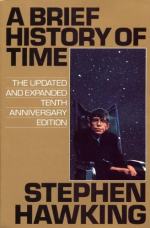
|
Introduction by Carl Sagan
1. Who wrote the introduction?
(a) Max Planck.
(b) Carl Sagan.
(c) Edwin Hubble.
(d) Stephen Hawking.
2. Most people believe that since the universe had a beginning it must have a what?
(a) A middle.
(b) An end.
(c) A timeline.
(d) A birth.
3. Philosophers try to understand the universe using what method?
(a) Mathematics.
(b) Religious reasoning.
(c) Circular arguments.
(d) Disciplined logic.
4. Scientists start their understanding of the universe with what?
(a) A theory.
(b) Observations.
(c) Mathematics.
(d) Observations and mathematics.
5. Stephen Hawking has what disease?
(a) Cancer.
(b) Ancel Hoffman disease.
(c) AIDS.
(d) Lou Gehrig's disease.
6. In what year did Stephen Hawking enter the Royal Society of London?
(a) 1973.
(b) 1974.
(c) 1972.
(d) 1975.
7. The writer of the Introduction hints that time might be able to move in what direction?
(a) Backwards.
(b) A repeat cycle.
(c) Sideways.
(d) Forwards.
8. Unlike children, scientists and philosophers, most adults use what to explain away the fundamental questions of the universe?
(a) Religion.
(b) Common sense.
(c) Logic.
(d) Dreams.
(read all 180 Multiple Choice Questions and Answers)
|
This section contains 4,010 words (approx. 14 pages at 300 words per page) |

|




